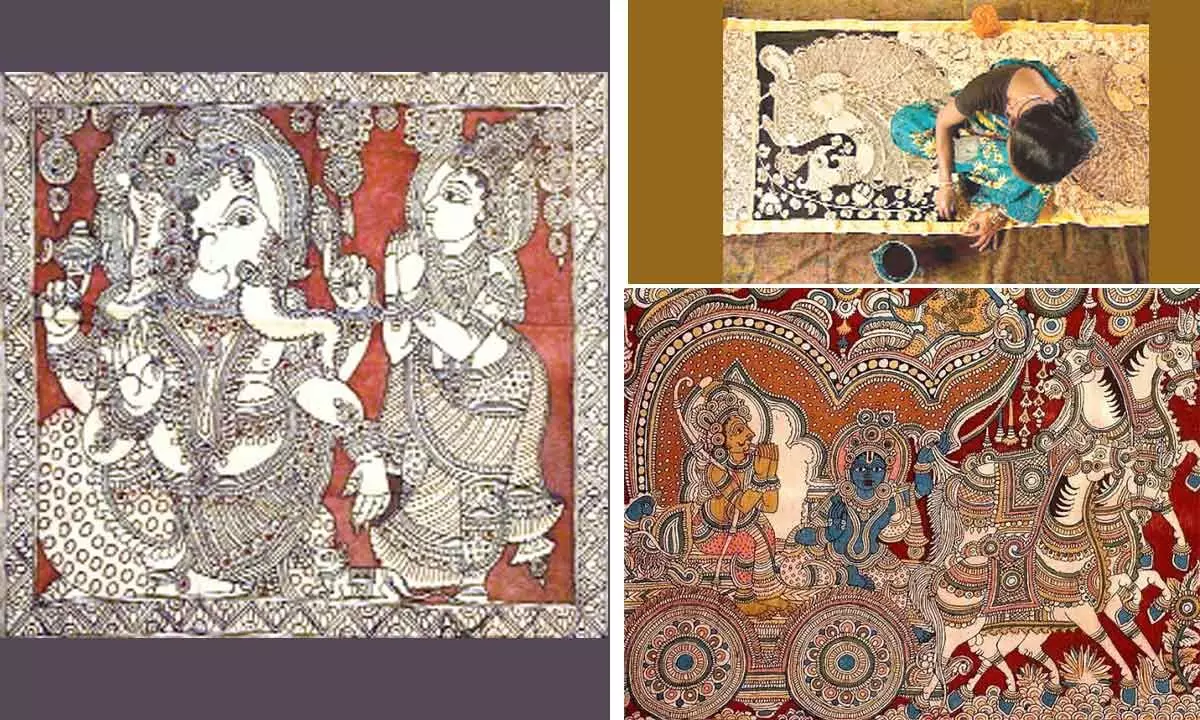Live
- Seven-day national mourning in respect of Dr. Manmohan Singh
- 'I've lost a mentor and guide': Rahul Gandhi grieves demise of Dr. Manmohan Singh
- 'Great loss for all of us': President Droupadi Murmu mourns Manmohan Singh's demise
- Dr Singh presented milestone budget of 1991 which liberalised Indian economy: FM Sitharaman
- PM Modi condoles demise of Dr. Manmohan Singh
- Former Prime Minister Manmohan Singh Dies at 92: A Legacy of Economic Reforms
- Nagesh Trophy: Telangana, Gujarat dominate action on Day 4 with easy wins
- Get Ready for Dreame Technology’s Year-End Amazon Sale – Big Savings on Smart Home Products
- FIR registered as 4 voter forgery cases come to light in Delhi's Okhla constituency
- Ayodhya Ram temple to host majestic anniversary celebrations on Jan 11 with devotional, cultural programmes
Just In
The diary of a dairy fabric–Srikalahasti Kalamkari


Located in the holy district of Tirupati, in Andhra Pradesh, Srikalahasti has been long associated with the craft of Kalamkari.
Located in the holy district of Tirupati, in Andhra Pradesh, Srikalahasti has been long associated with the craft of Kalamkari. An art form that goes as far back as 3000 years, Kalamkari evolved its way through several rounds of trial and error.
Majestic yet approachable, intricate yet bold, ancient yet eternal – Srikalahasti Kalamkari is everyone's favourite for reasons so obvious yet mystical in nature. One of the oldest crafts that stood the test of time, Kalamkari (both Machilipatnam and Srikalahasti) is a beautiful expression of art, that employs putting pen to fabric - 'Kalam' for pen, and 'kari' for craftsmanship.
Located in the holy district of Tirupati, in Andhra Pradesh, Srikalahasti has been long associated with the craft of Kalamkari. An art form that goes as far back as 3000 years, Kalamkari evolved its way through several rounds of trial and error. An offspring of the alliance between the Persian and Indian trade merchants, Kalamkari owes its blended design style to the Persian motifs finding harmony with Indian stories. Popular scenes from the most celebrated Indian epics – Ramayana and Mahabharata – are imagined, designed, and painted onto the fabrics for the connoisseurs to wear them. Between the two types of Kalamkari – Machilipatnam and Srikalahasti – the former employs block-printing and the latter uses a bamboo pen to bring designs to life. One of the reasons that is attributed to the roaring success of Kalamkari in the town of Srikalahasti, is the presence of the river Swarnamukhi which is known for its clean water. With regards to Kalamkari in Srikalahasti, it seems to have been around for about two centuries. That said, the artisans in Srikalahasti, have always ensured that the traditional techniques employed in this tradition were preserved and practised diligently, with a vision of this art form to continue for posterity. Thanks to their efforts, it even received a GI tag in 2006.
A completely natural-dye-based painting technique, Srikalahasti Kalamkari owes its differentiating personality style to the colours used. The mellow colours, so intrinsic to their designs, are absolutely sourced naturally. Red, yellow, and blue, for instance, are extracted from Indigo leaves. Black on the other hand is achieved by bringing together jaggery and iron with water. Perhaps the veterans of Kalamkari just knew where to look, to make life and living the most colourful.
Deceivingly simple-looking in its design, Kalamkari painting is a 25-step process. From the outlining of the design to the ironing of the final fabric – the original Srikalahasti Kalamkari style is completely handmade throughout its process. The foremost step is to source the cotton fabric from the market, following which the starch and dirt are washed. After drying the cloth, it the primed for what is perhaps considered the most unique part of the process – soaking the cloth for two hours in milk that is mixed with a powder made from Myrobalan. The milk-soaked cloth is then dried before it is ready for painting. Like every handmade design begins with outlining, Srikalahasti Kalamkari is no different too. With the use of a burnt tamarind stick, a basic outline of the design is sketched, following which a pen made of a bamboo stick – also known as a Kalamkari pen –with the help of cotton and sponge, is used to define black-er and better outlines.
The backgrounds albeit are typically coloured in Kalamkari-red. All these colours are then left to dry before they are washed in a river to let go of the excess colours. The cloth is then dyed completely in red by soaking it in a boiling pot of red-coloured solution, which then is laid out on the sand for the colour to spread evenly and get bleached under the sunlight. Once again, the cloth is then soaked in milk – but this time for the colour to stick to the fabric and not spread outside the outlines. Fun fact: the fat in the milk acts as an adhesive between the colours and the fabric. And finally, the cloth is ready to own the Kalamkari blues and golden hues in the non-dyed areas – after which it is washed and dried, one more time.
Such is the labour of love and art – of Srikalahasti Kalamkari. While many artisans still continue to use the bamboo pen, the shift towards synthetic pigments is often attributed to the generally high demand for this craft as well as the operational challenges faced in monsoons. Today, a lot of digitally printed sarees are sold as Kalamkari, however, the true test to finding an authentic one is by seeing if it smells like milk.
(The writer is a handloom and handicraft enthusiast. She is also a member of the crafts council. Instagram handle: Rajeswariramachander)

© 2024 Hyderabad Media House Limited/The Hans India. All rights reserved. Powered by hocalwire.com






